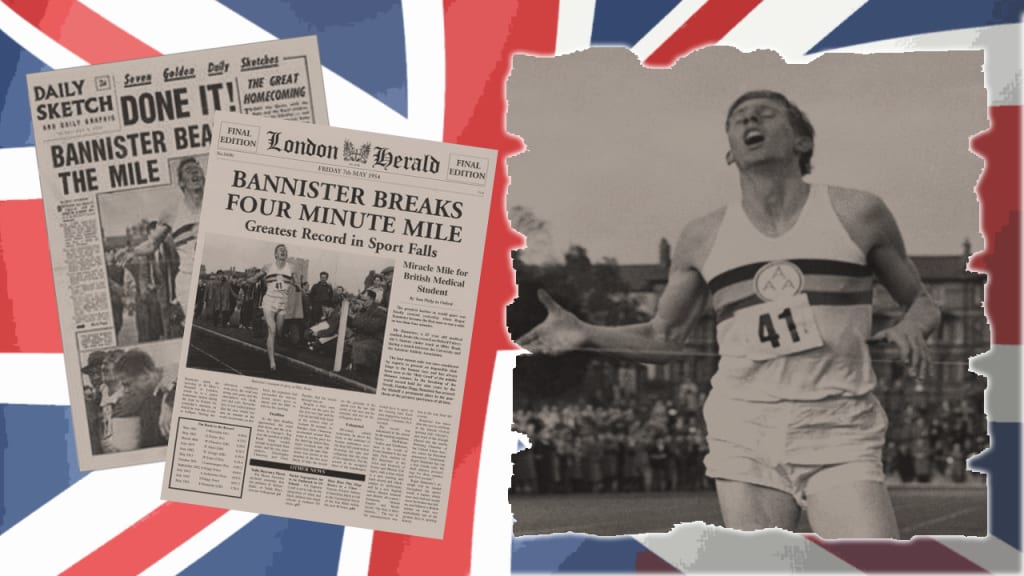It's always possible to go faster but some records can never be beaten
Bannister's mark was one of those milestones

The fastest time taken to run a mile was recorded on 7 July 1999 in Rome by Moroccan middle-distance runner Hicham El Guerrouj.
Considered by many to be the greatest middle-distance runner of all time, El Guerrouj set the mark at 3:43.13… an incredible 16 seconds faster than the mile had been covered 45 years previously when Britain’s Roger Bannister became the first man to dip under four minutes.
Bannister’s mark of 3:59.4 was set at Iffley Road Track in Oxford on 6 May 1954 and remained the best time for little over a month until Australian John Landy began the process of lowering it.
But when Bannister passed away three years ago today on 3 March 2018, his time was still etched in history and as memorable as ever more than 66 years after he set it, perhaps even more so than that of El Guerrouj, whose record has stood for more than 20 years.
Although Bannister’s mark was quickly bettered it’s significance at the time makes it one of the most enduring achievements in the world of athletics, a milestone that showed what a man could achieve when he really put all his efforts into it.
Breaking the previous record of 4:01.4, held for nine years by Sweden’s Gunder Hagg, was almost incidental such was the amazement at Bannister’s ability to break the “psychological” barrier that four minutes represented. At the time the general belief held that running a mile in less than four minutes was impossible… but Bannister proved that notion wrong, paving the way for the likes of Landy, Herb Elliott, Peter Snell, Filbert Bayi, Sebastian Coe, Steve Ovett, Steve Cram and Noureddine Morceli to make the challenge even harder for El Guerrouj.
Bannister was born on 23 March 1929 in Harrow and moved to Bath with his parents, Ralph and Alice, and sister, Joyce, shortly after the outbreak of World War II and continued his education at City of Bath Boys' School, where he discovered a talent for cross country running, winning the junior cross-country cup three consecutive times.
In 1944 the family returned to London and Bannister went to University College School in Frognal before going on to study medicine at Exeter College, Oxford.
Bannister continued his running at Oxford and was selected as an Olympic “possible” in 1948 but declined as he felt he was not ready to compete at that level. But, inspired further by watching the 1948 Olympics, Bannister set his training goals on the 1952 Olympics in Helsinki.
Unfortunately those games in Finland didn’t go according to plan and a despondent Bannister finished fourth in the 1,500 metres, which proved to be one of the more dramatic finals in Olympic history. The race was not decided until the final metres, with Luxembourg’s Josy Barthel winning in an Olympic record time of 3:45.28, with the next seven runners all under the old record. And despite missing out on the medals Bannister set a British record of 3:46.30 in the process.
After his disappointment in Helsinki, Bannister spent several months deciding whether to give up the sport but eventually decided on a new goal: to be the first man to run a mile in under four minutes.
On 2 May 1953 he made an attempt on the British record at Oxford, paced by Chris Chataway, and shattered Sydney Wooderson's 1945 standard in a time of 4:03.6. Later that summer on 27 June a mile race was inserted into the programme of the Surrey schools athletic meeting, presenting another opportunity for Bannister to try to go below four minutes.
Australian runner Don Macmillan, ninth in the 1,500 metres at the 1952 Olympics, set a strong pace with a time of 1:59.7 for two laps. He gave way for Chris Brasher to pick up the pace during the next circuit, the Briton having jogged the race and allowed Bannister to lap him so he would be fresh to kick on going into the final lap.
At the 3⁄4-mile mark Bannister was at 3:01.8, with the first sub-four-minute mile in reach, but the effort ultimately fell short with a finish in 4:02.0, a time bettered only by Arne Andersson and Hagg. And, since Bannister had used pace-setters, officials would not allow his performance to stand as a British record.
But Bannister was not alone in targeting a sub-four-minute mile, other runners were coming close as well. American Wes Santee ran 4:02.4 on 5 June that year, the fourth-fastest mile ever, and at the end of the year Landy ran 4:02.0.
Early the following year Landy made further attempts at the mark, running 4:02.4 in Melbourne on 21 January and then 4:02.6 on 23 February, which he repeated at the end of the Australian season on 19 April.
For Bannister, who had been closely following Landy's attempts, it seemed time was running out and so the scene was set for his next attempt on 6 May during a meeting between British AAA and Oxford University at the Iffley Road Track.
The pace-setters from his 1953 attempts, future Commonwealth Games gold medallist Chataway and future Olympic Games gold medallist Brasher, combined to lead Bannister in his bid for glory.
The race went off as scheduled at 6pm, Brasher and Bannister heading immediately to the front of the pack. Brasher led the first lap in 58 seconds and the half-mile in 1:58, with Bannister tucked in behind. Chataway then moved to the front after the second lap and maintained the pace with a 3:01 split at the final bell. He continued to lead around the front turn until Bannister began his finishing kick with just over half a lap remaining… bursting to victory in a time of 3:59.4 to the adulation of the 3,000 spectators at the track. Bannister had done it… the first man to complete a mile in under four minutes.
It took Landy just 46 days to break Bannister's record on 21 June in Turku, Finland, in a time of 3:58.0… but who really remembers that now.
After retiring from athletics in 1954, Bannister spent the next 40 years working as a neurologist and was married to Swedish artist Moyra Jacobsson, the daughter of economist Per Jacobsson. They had four children... Carol, Clive, Thurstan and Charlotte.
In 2011 Bannister was diagnosed with Parkinson's disease and died on 3 March 2018, aged 88.
About the Creator
Steve Harrison
From Covid to the Ukraine and Gaza... nothing is as it seems in the world. Don't just accept the mainstream brainwashing, open your eyes to the bigger picture at the heart of these globalist agendas.
JOIN THE DOTS: http://wildaboutit.com






Comments
There are no comments for this story
Be the first to respond and start the conversation.